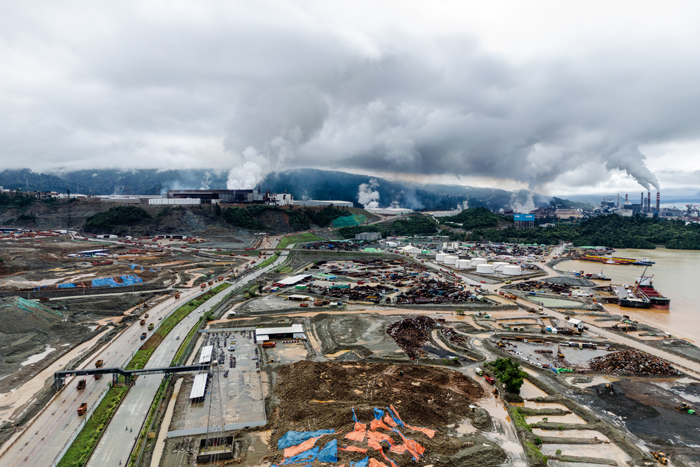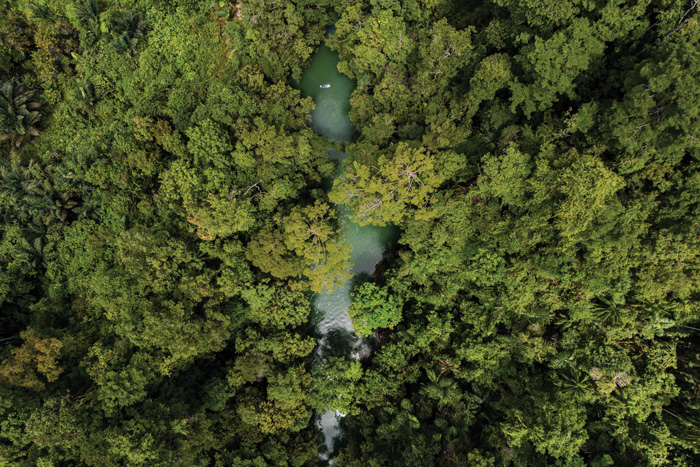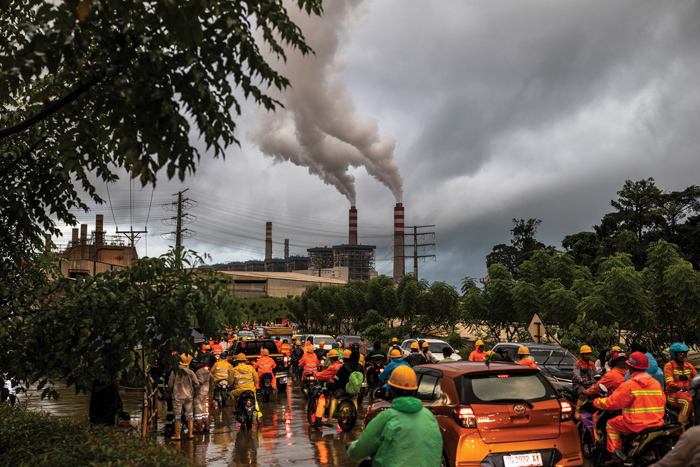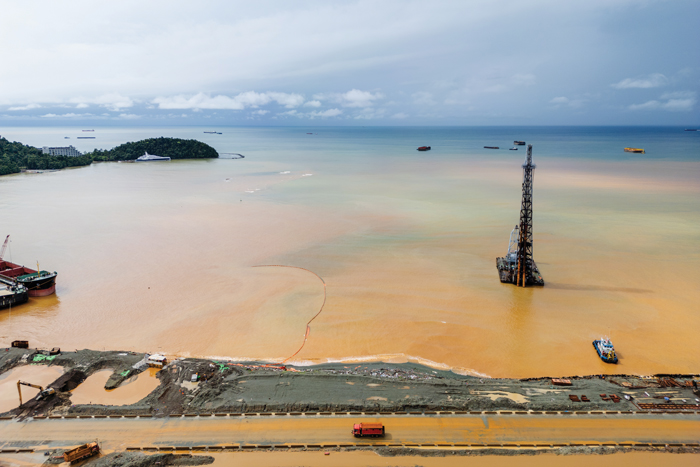The Dirty Secret Behind Shiny “Green” Nickel
Mining and processing this key battery component has wreaked havoc in nickel-rich lands from Siberia to Indonesia.
Nickel ore mined in South Sulawesi’s Molawe district is loaded onto barges for transport to processing plants elsewhere on the Sulawesi coast.
The history of Norilsk, Russia, is nasty, brutish, and short. In the 1920s, explorers discovered deposits of nickel, copper, cobalt, and other minerals on a remote peninsula in northernmost Siberia. Soviet dictator Joseph Stalin wanted them, but finding workers to build an industrial complex and adjoining city in a place where the temperatures are well below freezing most of the year posed a problem. Stalin solved it by simply forcing prisoners to do the job. An estimated 300,000 prisoners cycled through what was dubbed the Norilsk Correctional Labor Camp before it was finally closed in 1955. At least 16,000 of them died, taken by malnutrition, disease, and the occasional execution. It was probably little consolation to their families that Norilsk Nickel, the enterprise they helped build, had, by then, become one of the Soviet Union’s most important producers of metals, including the one it is named after.
Humans have been using nickel for ages, but we didn’t actually realize it until fairly recently. The metal often comes mixed in ore deposits with copper and iron, adding a silvery shine that ancient blacksmiths liked for their tools, weapons, and armor. It wasn’t until 1750 that metallurgists in Saxony came across some copper ore that was lighter in color than usual. They processed it down into an especially bright, silvery, extremely hard material they hadn’t seen before. Flummoxed, they dubbed it kupfernickel, meaning something like “goblin’s copper” or “copper with the Devil in it.” The following year, a Swedish mineralogist isolated the element and named it nickel. It turned out to be useful for adding luster, reducing weight, and increasing corrosion resistance in tools and weapons. Many countries used it to make shiny, long-lasting coins, including the eponymous US five-cent piece (though that coin is, oddly, made mostly of copper).
Nickel really established its place in the modern world in the 1820s, when scientists figured out that blending it with steel yielded a much stronger, more rust-resistant alloy. Soon, nickel-enhanced steel was being used in guns, ammunition, and vehicles, including to armor warships. Then, in 1913, a British metallurgist came up with a mix of carbon, chromium, nickel, and steel that formed a new, rust-resistant compound that was dubbed “stainless” steel. It turned out to be tremendously handy for everything from kitchen faucets to refrigerators to cutlery.
Stainless steel consumes the lion’s share of the world’s nickel output, but batteries are gaining fast. That’s not only because manufacturers around the world are producing more and more batteries containing nickel, but also because many of those manufacturers are increasing the amount of nickel used in those batteries. The more nickel a battery contains, the more energy it can store, meaning a car can travel farther on a single charge. The battery in a typical Tesla, for instance, is as much as 80% nickel by weight. The battery industry’s consumption of nickel jumped 73% in 2021 alone. The single biggest source of all that nickel was Norilsk.

After Stalin’s death, the new Soviet regime phased out forced labor at Norilsk in favor of salaried workers. When the Soviet Union collapsed and the state’s assets went up for grabs, a former Ministry of Foreign Trade apparatchik named Vladimir Potanin gained control of Norilsk Nickel. The company has since made him into one of Russia’s richest oligarchs, boasting a net worth estimated at more than US$30 billion. Norilsk Nickel, sometimes known as Nornickel, is today a major producer of cobalt, copper, and platinum, and the world’s leading supplier of high-grade nickel. Its customers include battery makers around the world. “The Company produces metals essential for the development of a low-carbon economy and green transport,” declared its 2022 annual report—an unfortunately accurate statement.
Along the way, Nornickel earned another distinction: it created one of the most ecologically ravaged places on Earth. “The company’s pollution has carved a barren landscape of dead and dying trees out of the taiga, or boreal forest, one of the world’s largest carbon sinks,” wrote journalist Marianne Lavelle in a 2021 exposé in Undark magazine. At the time, Norilsk emitted as much sulfur pollution as the entire United States. “Satellite instrument readings show no other human enterprise—no power plant, no oil field, no other smelter complex—generates as much sulfur dioxide pollution,” continued Lavelle. “The only entities on Earth that rival or surpass Norilsk’s sulfur emissions are erupting volcanoes. . . In volcanoes, however, emissions die down during times of dormancy, while at Norilsk Nickel, the pollution has been steady or rising for nearly 80 years.” (The company claims to have significantly cut sulfur emissions since then.) Just to top all that off, in 2020, one of the company’s massive fuel tanks collapsed, sending some 20,000 tons (over 18,000 metric tonnes) of foaming red diesel cascading into the Ambarnaya River and other waterways. President Putin declared it a federal emergency. Nornickel was forced to pay a US$2 billion fine, the highest in Russia’s history, and has pledged to spend billions more on pollution control.
The more nickel a battery contains, the more energy it can store.
Despite all of that, Nornickel remains a major supplier. Nornickel raked in US$3.6 billion from nickel sales in 2021 alone. Its importance was made clear by Western countries’ quiet decision to exclude it from sanctions for a full two years after Russia invaded Ukraine. In the first year of the Ukraine war, Potanin himself was hit with international sanctions—his assets were frozen, and he was banned from traveling to some countries. But Nornickel’s metals were still flowing freely into the world market at the end of 2022, ten months after the invasion of Ukraine. In fact, European Union and US imports of Russian nickel increased that year. It wasn’t until spring of 2024 that the US and UK finally banned imports of Russian copper, nickel, and other metals.
Western leaders have been acutely concerned about nickel supplies for years. A 2021 US government report warned of a possible impending “large shortage” of high-grade nickel. “Please mine more nickel,” Tesla chief Elon Musk begged mining companies in 2020. “Tesla will give you a giant contract for a long period of time if you mine nickel efficiently and in an environmentally sensitive way.” Indigenous people in the Norilsk area have written an open letter to Musk, asking him not to buy from the company until it compensates them for turning their ancestral lands into “a lunar landscape.” Musk did not respond. Perhaps that’s because he and the rest of the nickel industry are shifting more of their attention from Siberia to the South Pacific and the fast-growing nation of Indonesia.

Nirwana Selle was an unlikely TikTok star. The 21-year-old Indonesian woman’s first job out of vocational school was operating a crane at PT Gunbuster Nickel Industry, a Chinese-owned nickel-smelting plant on the island of Sulawesi. She turned the industrial setting into a backdrop for her videos, filming herself at work inside the crane’s control room, wearing a hard hat over her hijab and an impish smile on her face as she moved containers of molten metal around or lip-synched along to pop songs. The videos drew millions of views. In her final post, in December of 2022, she rides a motor scooter down a gravel road outside the plant while a saccharine soundtrack plays.
Four days after recording that video, Selle was up in the control room working the night shift when a coal-dust leak sparked an explosion and fire. She and a coworker, Made Detri Hari Jonathan, were trapped inside the room as flames roared up, according to Vice News. In a video someone shot at the scene, you can hear screaming. Selle and Jonathan were incinerated. Nothing was left but their bones.
The US$2.7 billion plant had only been operating for a year, and yet Selle and Jonathan were just two in a series of workers who had died there. A bulldozer operator had been swept out to sea by an avalanche. Another worker fell into a cauldron of molten slag. The deaths of Selle and Jonathan were the last straw. Hundreds of their Indonesian colleagues went on strike to demand justice and better safety protections. In January of 2023, the strike descended into chaos. The Indonesian workers set fire to dormitories and brawled with Chinese guards. Two workers were killed in the melee. More than 500 police and soldiers were sent in to restore order. Just six months later, yet another fire at the plant killed one worker and injured six more. Six months after that, an explosion at another nearby nickel processing plant, also run by Gunbuster, left 18 workers dead.

The carnage at the Gunbuster facilities is just one of the horrific side effects of Indonesia’s bid to use its vast mineral wealth to boost itself into a top position in the electric-vehicle industry. The nation of nearly 300 million holds enormous nickel reserves and for years has been the world’s biggest producer of the raw metal. In 2020, however, the government banned exports of unprocessed nickel; only refined products were allowed to leave the country. The goal was to force foreign buyers to invest in building up higher-value refining and manufacturing in Indonesia itself. “We don’t just want to build batteries. This is just half of it. We want to build electric cars in Indonesia,” President Joko Widodo told Bloomberg Businessweek.
From an economic standpoint, the gambit has paid off. Investment has poured in, and production has shot up. Chinese companies, including the parent company of Gunbuster, lead the pack; according to Bloomberg, they have collectively sunk more than US$14 billion into nickel refineries, smelters, and other operations on Sulawesi and another nickel-rich Indonesian island. Ford and other non-Chinese multinationals are investing billions more. Tesla has signed multibillion-dollar deals with Sulawesi-based companies and may set up its own manufacturing facility in Indonesia. In the two years following the raw-metal export ban, the value of Indonesia’s nickel exports leapt tenfold to US$30 billion.
Among the pollutants is the same cancer-causing toxin Erin Brockovich campaigned against.
The collateral damage to the environment, however, is prodigious. To clear land for new mines and related infrastructure, more than 21,000 acres (85 square km) of rainforest have been wiped out in one area of Sulawesi alone. That’s an area slightly larger than all of St. Thomas, the biggest of the US Virgin Islands. Tailings and other mine waste have polluted streams and waterways. Among the pollutants the mines emit is hexavalent chromium—the same cancer-causing toxin that Erin Brockovich famously campaigned against—which has seeped into drinking water in some areas, according to the Guardian. That toxin has also turned up near mines in the Philippines, another major nickel producer. In 2017, more than a dozen nickel mines there were shut down because of the damage they were doing to the environment. Nonetheless, nickel mining is expanding rapidly in the Philippines and has sparked violent clashes between local protesters and police.
On top of the damage caused by nickel mining, that higher-value nickel processing generates even more pollution. Nickel comes in two basic forms: sulfides and laterites. Both require processing to be refined into battery-grade metal, but nickel sulfides require much less processing than laterites. Russia has lots of sulfides. Most of Southeast Asia’s nickel, however, is lower-quality laterites. Refining this kind of nickel is considerably dirtier and more complicated. It often involves a process called high-pressure acid leaching, in which the ore is crushed, heated to more than 400℉, mixed with sulfuric acid, and pressurized to separate out the nickel. This method produces millions of tons of acidic waste that need to be handled somehow. Indonesian villagers say runoff from acid-leaching refineries has turned their rivers dark red. One Chinese-owned nickel refinery in Papua New Guinea leaked 35,000 tons (almost 32,000 metric tonnes) of waste into the sea along the country’s northeastern coast in 2019, contaminating the water so badly that the government temporarily banned fishing, one of the main sources of local employment. That accidental leak came on top of all the mine tailings that same refinery deliberately and legally dumped directly into the Pacific.

Then there is the filth released into the air. The refineries’ smokestacks spew out sulfur dioxide and other pollutants. The New York Times reported in 2023 that people living near a Sulawesi plant “complain about the dust pouring off piles of waste, the belching smokestacks, and trucks rumbling past at all hours bearing ore. On the worst days, residents don masks and struggle to breathe.” Nickel processing also devours huge amounts of energy, and most of Indonesia’s electricity is generated by coal-fired plants. That’s right: huge amounts of carbon-intensive coal are being burned to make carbon-neutral batteries.
Despite all of this, countries in the region are also scaling up their nickel industries. Fully one fourth of all the world’s nickel may be in the tiny French territory of New Caledonia, in the South Pacific. That mineral wealth hasn’t exactly been a blessing. New Caledonia has been wracked by periodic spasms of violence as the Indigenous Kanak people have battled with descendants of European settlers and other newcomers over the division of the metal booty. Unrest over nickel brought down the local government in 2021.
Meanwhile, the United States is home to only a single nickel mine, located in Michigan. It is expected to be tapped out by around 2026. There’s another in the works in Minnesota, but it has been stalled by lawsuits and permitting issues since 2005. In any case, any nickel that is dug out of American soil still has to be sent abroad to be processed. While one or two companies are working to start up domestic nickel refineries, the US currently has none.
From Power Metal: The Race for the Resources That Will Shape the Future, published by Riverhead Books. Copyright © 2024 by Vince Beiser. Reprinted with permission. Follow Vince’s ongoing reporting in his Power Metal newsletter.
This story was first published on The Green House, our membership platform. Join us there for early access, discounts and freebies, community discussions, and to support our work telling the large and small stories of how we can live sustainably.
Print Issue: 2025—Issue 1
